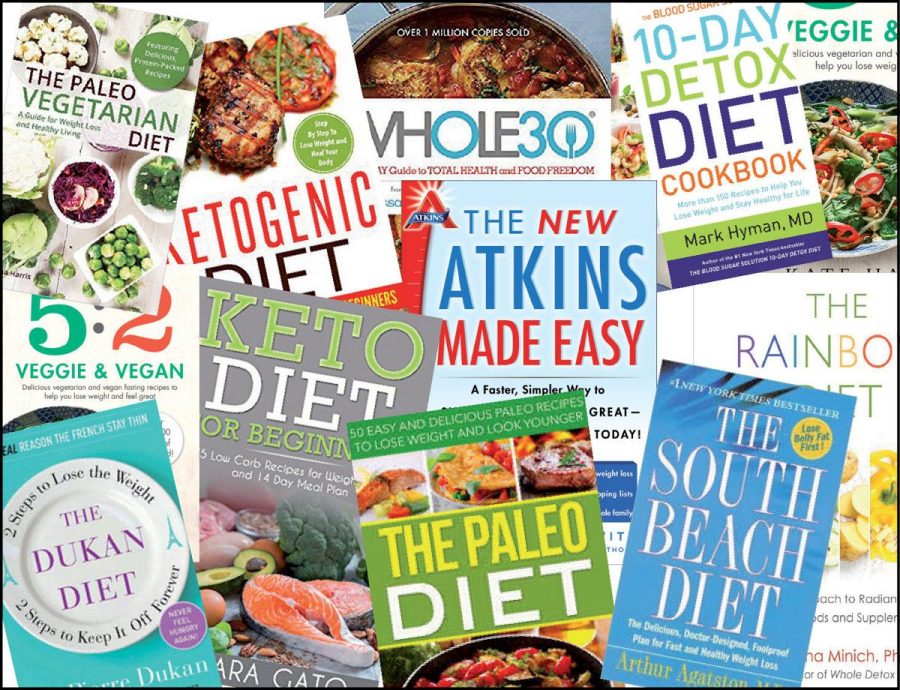Following the Fad
Fad diets offer benefits but at what cost
photo courtesy of Tri-County TImes
When looking at the term “Fad diet” there are a seemingly endless number of diets associated with it. Each diet boasts different benefits, but also a number of health problems with it. Several individuals have studied certain diets and and written books to convey their findings. There are a multitude of diets and therefore, a large number of resources at people’s disposal.
September 25, 2019
Throughout an individual’s lifetime, the phrase “I need to go on a diet” is one that is heard quite often. This statement, although only a short seven words, holds a lot of meaning behind it. A person may dislike their appearance and wish to change it, or perhaps they simply wish to “clean up their diet” as it may be lacking the inclusion of several food groups.
Now that the decision to change one’s diet is made, the question arises of where to start? There are a multitude of options to explore, and naturally, one of the first things that a person may do is consult the Internet. Within milliseconds, the page is filled to the brim with websites offering advice, blogs, meal options and a mammoth of other results for one to explore.
Out of all these available resources, an option that people may consider is the use of a Fad diet. This term refers to a diet that is popular for a time, similar to a fad in clothing. These diets promote extreme weight loss and usually boast other health advantages, such as a prolonged life. People often turn to these if their situation is bad enough, hoping to take advantage of the little effort they require, but the consequences of using these meal plans can have a detrimental toll on an individual’s health.
While the use of these diets may sound appealing, the cons continue to outweigh the benefits. According to the Cleveland Clinic, some of these diets require eliminating certain foods that contain nutrients essential for survival. Fad diets may include those that are fat-free, very-low-carbohydrate or high protein. Some focus on a particular food, such as grapefruit or cabbage, or may have one eliminate certain foods at specific times of the day. Others allow certain foods, as long as one eats them along with certain other foods. There is so much involvement and planning with these diets, that it’s almost discouraging because of how much effort it requires to actually make one of these diets successful.
When people hear the words “Fad diet,” some of the diets that may come to mind are Paleo, Keto (Ketogenic), Atkinz and vegan diets. Out of all the Fad diets in existence, these are the ones most widely used and least dangerous to the user. The diets all have different specifications and guidelines to follow. For example, the Paleo diet, also known as the caveman diet, consists of eating foods that would’ve been attainable during the Paleolithic era. It mainly includes lean meats, fruits, vegetables, nuts and seeds. All of this food would’ve been obtained by hunting and gathering, which eliminates any processed sugars and processed food from the user’s diet.
Although this example of a widely used diet sounds extremely appealing, it restricts the user to considerably beneficial foods, the diet subjects the user to a large intake of fats and proteins. This, according to UC Davis Health, can increase the risk of heart disease and certain cancers, due to the large consumption of saturated fats and proteins. The diet also puts consumers at risk for Vitamin D and calcium deficiency due to an absence of dairy products. These two items are critical to maintaining bone structure and health. As a person who has tried Paleo eating before, this definitely raises red flags in my mind, about how actually beneficial the diet really it. It doesn’t seem worth it to lose weight at the expense of potentially severe harm to one’s body.
While the Paleo diet has an absence of essential minerals, there are other detrimental consequences associated with the use of any Fad diet. According to the Better Health Channel, the use of any diet can cause dehydration, due to a large amount of water being lost, weakness, fatigue, nausea, headaches, constipation and a wide range of other health problems.
In addition to the more widely used diets, there are some more “questionable” diets, whose purpose and overall construction, baffle my 16-year old self. Upon further examination of the seemingly endless list of Fad diets, I discovered one known as the Cotton Ball diet. The name itself should already raise questions. This diet involves eating cotton balls soaked in various liquids. The cotton balls are intended to make the user feel ‘full’, while the liquid is for flavor and provides some amount of calorie intake.
Obviously, this is one of the more extreme Fad diets and is very dangerous. Cotton balls are not intended for consumption and are extremely hard on the user’s stomach to digest. According to Healthine, the cotton settles in the user’s stomach and can mix with mucus and other food particles and form a mass called bezoar and since the cotton can’t be digested, it can cause major intestinal obstruction. This diet shouldn’t even be labeled as a diet, rather it’s a very unhealthy form of disordered eating that no human should ever undertake. The concept of this even suggests that there is a larger issue at hand, besides the need to lose weight. There is little to no calorie intake which would suggest to me that undertaking this diet would further escalate all the previous negative effects mentioned.
As one can observe, the use of Fad diets shouldn’t be considered as an option for weight loss, due to the potential hazards that can surface with the use of the Fad diet. If people wish to change, they must find a plan that works for them and is sustainable. No individual is alike when it comes to how one’s body functions. What may be successful for one person may not work for another. The internet is a wonderful tool and should just be a tool. If an individual is truly serious about changing their diet, it’s best to consult a doctor to discuss a plan of action to ensure success and long-lasting results. These healthcare professionals are the best resources to use, as they can safely guide one on how to make the best changes possible, without the use of unhealthy and unsafe social trends.








